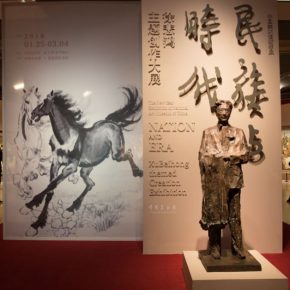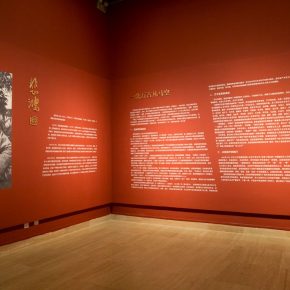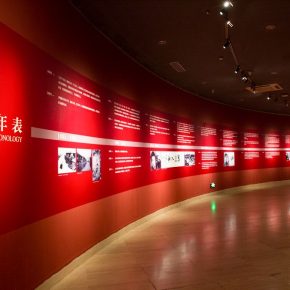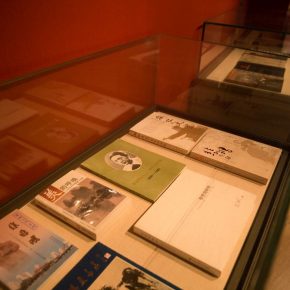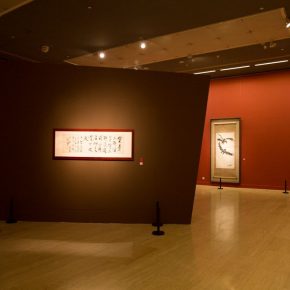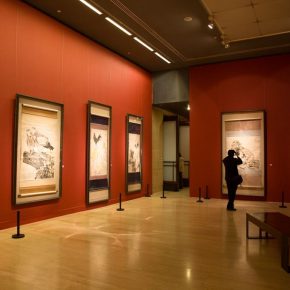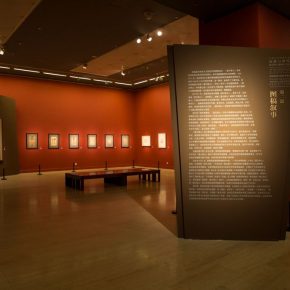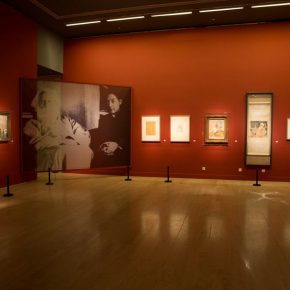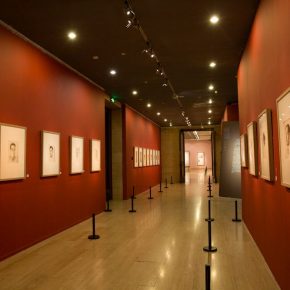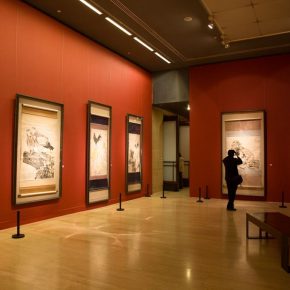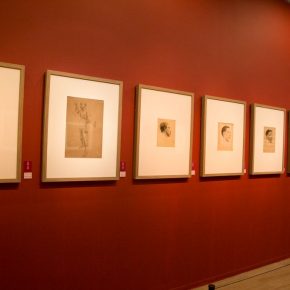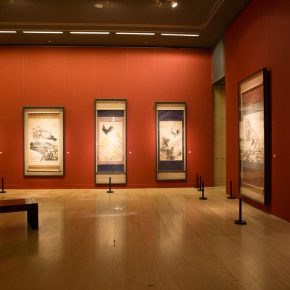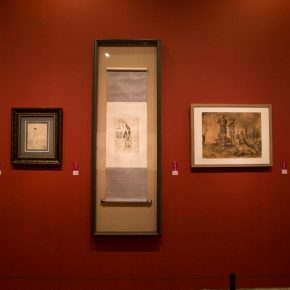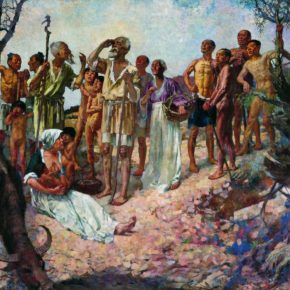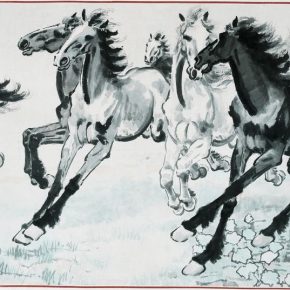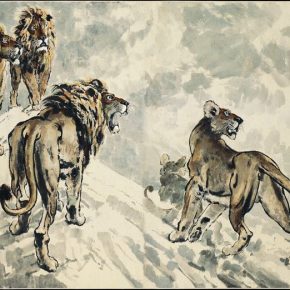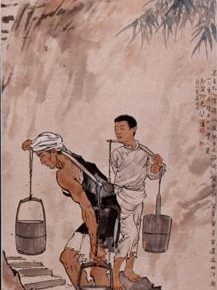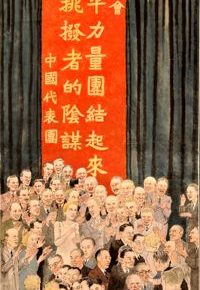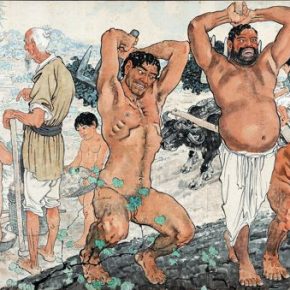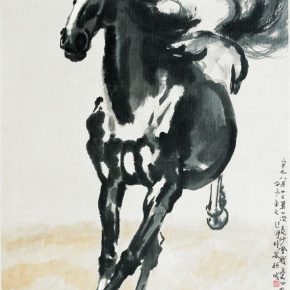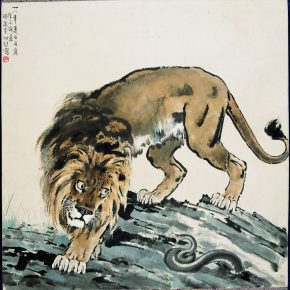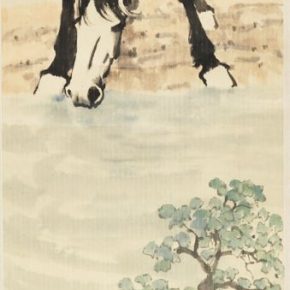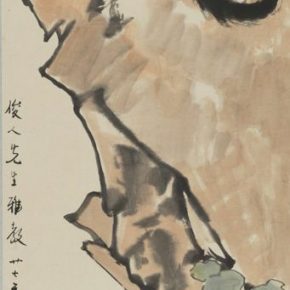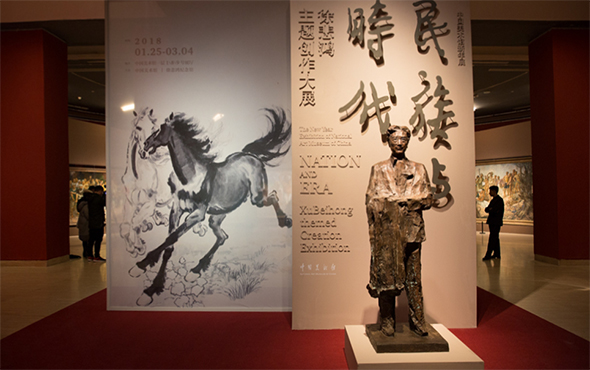
Speaking of Xu Beihong, the improvement of Chinese painting and the discussion on realism are topics that cannot be ignored. In 1918, Xu Beihong, who had not yet studied in France, proposed an idea in the “Methods for Improving Chinese Painting”: “Retain the advantage of the ancient Chinese painting, inheriting the one that is about to be extinct, changing the disadvantage, increasing the one that is not good enough, blending the advantage of the Western painting with Chinese painting.” After he returned from France in 1926, he made it clear that, “I personally believe that only the promotion of realism will change the decline of fine arts in China.” In 1929, the Ministry of Education of the Republic of China launched “The First National Art Exhibition” in Shanghai. The General Standing Committee of the Exhibition includes Xu Beihong, Wang Yiting, Li Yishi, Lin Fengmian, Liu Haisu, Jiang Xiaojian, Xu Zhimo. It presented 354 works covering a variety of styles such as realism, formalism, romanticism, impressionism, post-impressionism and futurism. However, when Xu Beihong discovered there were too many works of modernism in the exhibition, he rejected presenting his own work in the exhibition. What are the “realism” features of Xu Beihong, the revolutionary painter that practiced realism throughout his life?
Hosted by the National Art Museum of China and Xu Beihong Memorial Hall, “Nation and Times – Xu Beihong Thematic Creation Exhibition” was held in the National Art Museum of China on the morning of January 25, 2018. This exhibition sorts out and displays over 100 pieces of Xu Beihong which were landmarks of the times with great historical value. They are divided into three parts. Part One is the National Spirit, putting on display representative masterpieces of Xu, including “When Faith Moves Mountains”, “Wait for Me”, “Ba People Draw Water”, “The General Assembly for World Peace”, and “Join Forces in Tokyo”. Part Two is the Graphic Narrative, showing the rough sketches and line drawings of Xu Beihong in the creation of “When Faith Moves Mountains” and others. Many of the sketches are exhibited for the first time. Part Three is the Woes of the Family and Country, putting on a show of works of Xu Beihong with national symbolic significance, such as the “Horse”, “Lion”, and “Eagle” and a series of sketches for thematic creations.
Xu Beihong’s Realism Features
Xu Beihong’s theory in the reforming of Chinese painting advocated the use of realism to eradicate the defects of Chinese painting at that time. As early as 1918, Xu Beihong expressed his own ideas on realism: “The purpose of painting is ‘so skillfully imitated’ as to be indistinguishable from the original”. Xu Beihong’s realism is well represented in the Chinese painting “When Faith Moves Mountains”, and it used line drawing to outline the contours of human figures, clothing, trees & grass, fully reflecting the painting features of the traditional Chinese painting while focusing on conveying the spirit with images, combined with the realism of traditional Western painting. Xu Beihong organically combined the traditional Chinese and Western painting features and created a realistic painting style.
In 1927, Xu Beihong returned to China at the end of studying abroad for eight years. His early realistic thoughts and the education of classical painting that he received while studying abroad had greatly influenced the formation of his realistic painting. It features a large-scale painting entitled “Tian Heng Five Hundred Soldiers”, which was created shortly after the return of Xu Beihong, and the sketches. We will be surprised to see the portrait of Xu Beihong in this piece. Not only that, some scholars have found that there are some portraits of Xu Beihong’s relatives among more than 30 figures. In November 1939, invited by Tagore, Xu Beihong went from Singapore to India to hold an art exhibition and publicized the anti-Japanese art until he left India in December 1940. During this period, he created many works, of which the most influential piece is “When Faith Moves Mountains”. It also presents many manuscripts of figures and movements which have never been depicted in the painting, through the continuous narratives with images, Xu Beihong’s thinking on how to create works became increasingly clearer.
In India, Xu also drew many other sketches and drawings, including both local customs and various animals, portraits of great people and Indian landscapes, school music lessons and self-portraits, created the pieces of “Portrait of Gandhi”, “Indian Women”, “Forest of the Himalayas” and so on. Before creating the Chinese painting of “Portrait of Tagore”, Xu Beihong portrayed up to ten sketches of Tagore of different bearing. These distinctive pieces reproduce the realistic feature of Xu Beihong.
In fact, as a realistic painter, Xu Beihong only created a few pieces that directly portray the reality. The exhibition presents his work “Ba People Draw Water”, “The General Assembly for World Peace”. However, he had created a series of works indirectly depicting the reality. In the third part of this exhibition, it features the theme of animals such as horses, lions, eagles, vultures, chickens and cattle, integrating romanticism and symbolism in the pursuit of realism. These works, together with some calligraphic works and manuscripts are also on display, and several sketches which were recently discovered in Singapore are also shown for the first time.
It can be said that the origin of Xu Beihong’s pursuit of realism is not based on the critique of social reality. His realism is a realistic technique of painting, a realism based on the idea of improving Chinese painting. The writer believes that it is a feasible way to understand Xu Beihong and realistic art by discussing the whole exhibition and to offer a case study on one piece.
Xu Beihong’s Art is Controversial
In 1895, Xu Beihong was born in Yixing County, Jiangsu Province. Xu began studying classic Chinese works and calligraphy with his father Xu Dazhang when he was six years old, and Chinese painting when he was nine years old. In 1915, he moved to Shanghai, where he made a living off commercial and private work. He travelled to Tokyo in 1917 to study art. When he returned to China, he began to teach at Peking University’s Arts school at the invitation of Cai Yuanpei. Beginning in 1919, Xu studied overseas in Paris at the École nationale supérieure des Beaux-Arts, where he studied oil painting and drawing. His travels around Western Europe allowed him to observe and learn Western art techniques. In 1926, Xu Beihong returned to Shanghai from France and exhibited his creations over the years, arousing great concern in the literary and art circles. Over the next thirty years, Xu Beihong created many realistic works, which earned him a reputation.
It displays the classic realistic creations in the first chapter of this exhibition, including “When Faith Moves Mountains”, “Tian Heng Five Hundred Soldiers”, “Wait for Me”, and “Ba People Draw Water”. “Tian Heng Five Hundred Soldiers” was inspired by “Records of the Grand Historian”, depicting the scene of the Tian Heng departing with his five hundred soldiers. “Wait for Me” depicts a scene of people suffering the tyranny of Xia Jie, the last Emperor of Xia. Some people commented that these two paintings were the “first sound of art rejuvenation” in our country. “When Faith Moves Mountains” is also a theme of classical literature, and it mainly shows six brawny men stepping on the mountain and splitting stones. The realistic techniques of Xu Beihong incisively and vividly evidence the passionate laborers who were standing on the earth and striving to split stones.
Xu was known for this piece and it was also controversial. For example, Chen Zhenxia, who was of the generation of Xu Beihong, once criticized “Tian Heng Five Hundred Soldiers” as being improper in figures’ dresses, hairstyles and beards. It was followed by the British scholar Sullivan who reviewed the “Tian Heng Five Hundred Soldiers” and said that: “Although the theme is Chinese, his approach reflects the typical characteristics of the Western salon paintings of late 19th century – it is lack of an outstanding composition and the performance of real emotions at the dramatic moment.” Scholars also pointed out that “When Faith Moves Mountains” and “Wait for Me” had the same problem. The above criticisms were mainly based on the historical materials. On the other hand, the accusation mainly focuses on the choice of themes. According to Yin Dongping’s article of “Review on the Exhibition of the Art School and Xu Beihong’s Paintings”, it believes that Xu’s “When Faith Moves Mountains” “was the first time to use Chinese painting to perform such a big composition in China”, and “his skills are so perfect that we are not allowed to criticize, but we are not satisfied with the themes he has presented. If he can use his boldness mind and skills to portray present realistic themes and temporarily abandon the narratives of old stories, then he deserves brilliant glory at the time in the history of painting.”
Some further criticized Xu’s accomplishments as being related to his approach to politics to a certain degree. Some people believed that since the death of Xu Beihong, the unanimous affirmation given by mainstream discourse stemmed from the fact that his works were mainly dominated by ideology. Therefore, these people directly denigrated the art of Xu Beihong regardless of the fact. It is a “non-academic" criticism which is obviously not desirable. The writer agrees with the review made by Hua Tianxue, a doctoral student from the China National Academy of Arts in the dissertation of “Xu Beihong’s Improvement of Chinese Painting”: “For a long time, the understanding of ‘Tian Heng Five Hundred Soldiers’ and ‘Wait for Me’ has been limited by text-based descriptions, or a simple or arbitrary interpretation of political meanings. This kind of interpretation is often taken as a matter of course, regardless of the characteristics of art, regardless of the complexity of the art, artist and reality political relationships, ignoring an in-depth understanding and analysis of the painter’s thoughts and feelings.” Dr. Hua Tianxue carefully reviewed the affirmations and criticisms on Xu Beihong in the dissertation. Starting with the background of the great time, the specific works and Xu Beihong’s own situation, it made an objective comment on the art of Xu Beihong.
An academic seminar with reference to the exhibition was held on the 7th floor of the National Art Museum of China on the afternoon of the opening day, and Wu Weishan, Director of the National Art Museum of China, served as Academic Director. At the same time, it also presented “Blooming Flowers in a Flourishing Age – Exhibition of Elaborate Bird-and-flower Paintings Collected by NAMOC” and “Painting the Era – Exhibition of Jiangsu Artist Landscape Paintings to Carry Forward the Spirit of the New Jinling Painting School”. The exhibition remains on view till March 4.
Text and photo Yang Zhonghui/CAFA ART INFO (images of the artworks courtesy of the organizer)
Translated by Chen Peihua and edited by Sue/CAFA ART INFO


